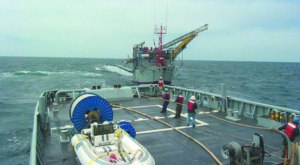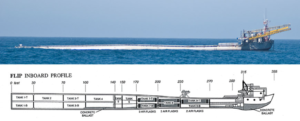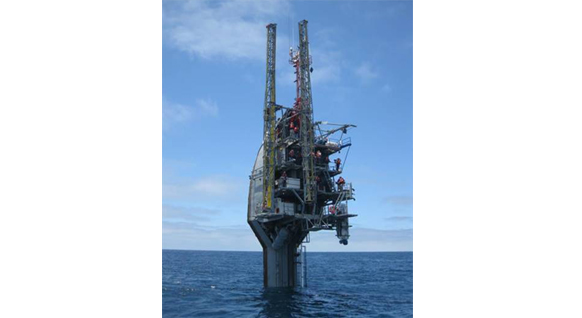R/P Flip – Ship of the Week Jan 26, 2017 | West Pacific Marine
Built in 1962, R/P Flip is a most unusual craft – her name being the acronym for “Floating Instrument Platform”. Strictly speaking she is not a ship at all, but an oceanographic research platform designed by scientists at Scripps’s Marine Physical and operated by Scripps Oceanography for the U.S. Navy. When not in use she is generally decked in San Diego Bay before being towed to out to sea in a horizontal (submarine type) position and then “flipped” 90 degrees so that about 120m of her length is below water creating something akin to a very stable spar buoy, resistant to wave motion. Her initial primary task was the study of sound propagation for submarine warfare, but with the development of new technologies she has evolved to support research in geophysics, meteorology and oceanography.
Built by Gunderson Brothers Engineering Corporation in Portland, Oregon in 1962
Owned and operated by Scripps Oceanography, San Diego, CA
Delivered in 1962
LOA 108m
Average beam 8.0m (diameter of the hull is 6.5 meters from the 91- to 49-meter depth, tapering to 4 meters at the 20-meter depth)
GRT 700 tons
Power supply 3 generators mounted on trunnions providing 340 kW to meet platform and scientific needs
Standard crew 5, research team 11
Endurance 35 days



The process of “flipping”: from a horizontal to a vertical position, a process takes only about 30 minutes and, depending on the mission, the vessel is allowed to either float freely or be anchored to the ocean floor at depths of up to 5,000 meters. Because its design accommodates riders in both horizontal and vertical positions, FLIP’s interior spaces often appear misleading and even bizarre, with doors mounted on the floor, portholes in the ceiling, objects mounted on swivelling trunions, and sinks and toilets mounted for both configurations. On completion of a mission, compressed air is pumped into the ballast tanks to return the horizontal to its horizontal position.

In 1903, members of the Scripps family and other community leaders established the Marine Biological Association of San Diego, building its first laboratory in La Jolla in 1905. The marine lab was subsequently renamed the Scripps Institution for Biological Research and became part of the University of California in 1912 and the the Scripps Institution of Oceanography in 1925 in recognition of the breadth of research underway at the institution. In 1960, the institution became a faculty of the University of California, San Diego and remains so.

